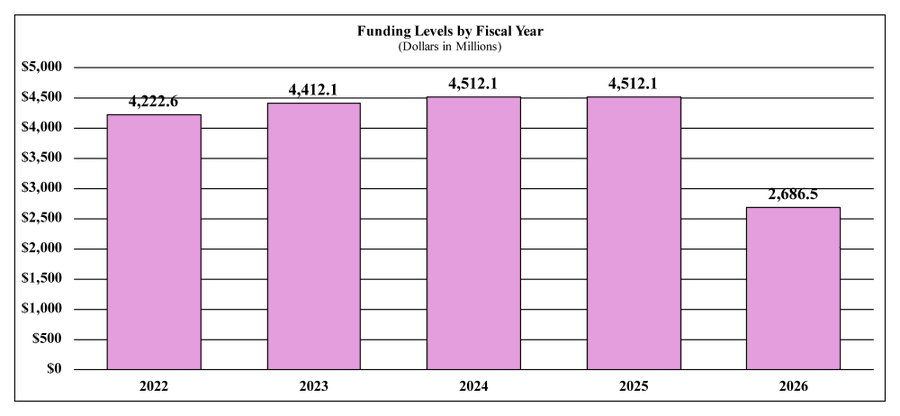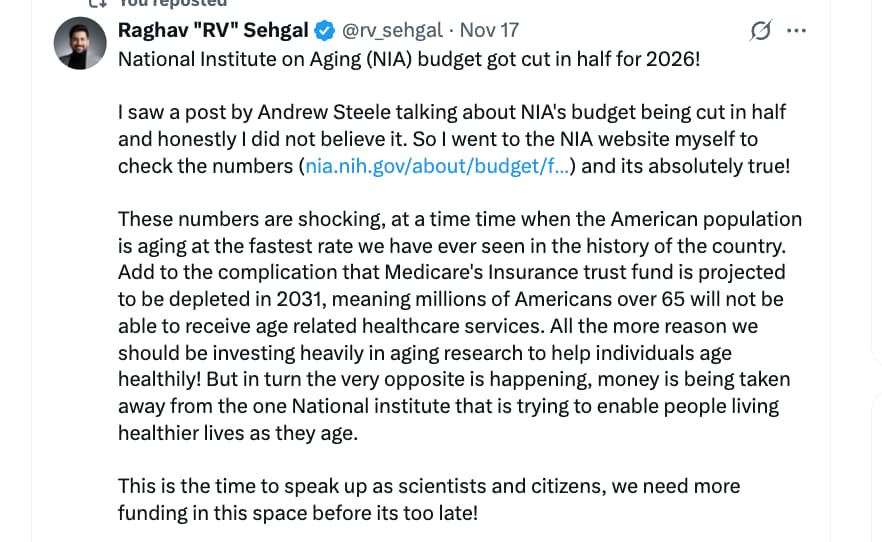In a fresh series of posts on X, Longevity Science advocate Andrew Steele highlights a dramatic and unprecedented reduction in the proposed budget for the U.S. National Institute on Aging (NIA) for fiscal year 2026: slashing $1.8 Billion from the budget, a cut of over 40% compared to the 2025 enacted level.
The National Institute on Aging (NIA) has traditionally been the world’s largest funder of research into the biology of aging and the key funding source for most of the longevity knowledge we’ve gained over the past few decades, including the ITP’s animal longevity studies on rapamycin.
This potential funding shortfall comes at a critical time for ageing-biology research, where investment is seen by many as pivotal to unlocking therapeutics and interventions that could address multiple age-related diseases. Additionally, funding in the biotech industry has largely dried up and many longevity startups are failing and closing shop. Between drastic federal cuts, and a dramatic contraction of private investment in biotech (down approximately 80% over the past few years) we are seeing the “nuclear winter” in longevity-focused R&D. The combined effect is likely to be dramatically slowed progress in the field. Given the vast reductions in funding, we have to ask ourselves "Is this the death of “longevity”?
Source: Biotech financing: darkest before the dawn (Nature Biotechnology)
Steele notes that ageing is the greatest underlying risk factor across cardiovascular, neurodegenerative and metabolic diseases—yet the funding trajectory appears misaligned with that risk profile. The budget reduction risks dramatically slowing ongoing translational efforts in geroscience, impairing projects targeting hallmarks of ageing (such as senescence, mitochondrial dysfunction, epigenetic drift) and delaying potential therapies that aim to extend healthspan.
The serious budget cut may undermine U.S. leadership in longevity science and slow progress in the already-underfunded field. Steele suggests that without adequate funding, the ability to scale early stage human trials, broaden biomarker platforms, and deploy population-based ageing interventions will be compromised.
The timing is also contentious since ageing research is increasingly cross-cutting — with implications for cancer, Alzheimer’s, frailty, and more.
Why it matters: If funding dries up, work on age-modifying therapies may stall at the preclinical or early-phase stage, meaning a delay in potential breakthroughs that could reshape preventive healthcare and longevity markets for many years to come. It’s also a generational impact on longevity researchers, as PHDs will be forced to leave the field and are unlikely to return; reducing the number of experts in the field who can move the science forward in the next decade. For entrepreneurs, investors and biomedical innovators (e.g., those in biotech or longevity devices), this is a strong signal to assess risk around the ecosystem supporting ageing-biology.
Bottom line: Steele’s posts serve as a warning flare: the infrastructure for ageing-research in the United States is facing fiscal headwinds. For a field that positions itself as a frontier of medicine and longevity intervention, this could slow momentum — and trigger a reassessment of funding strategy, partnership models and the pipeline of future products.
Source: https://x.com/statto/status/1990338898241970453?s=20
New Proposed NIA Budget (graphs): https://www.nia.nih.gov/about/budget/fiscal-year-2026-budget#graphs






